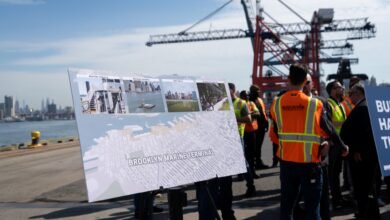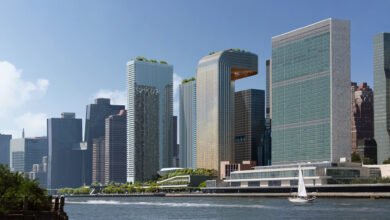Reports Project Higher Housing Loss in Midtown South
A 21-story vacant office building in the Garment District was a prime candidate for a residential conversion, after a key upzoning in Manhattan.
The listing for Expansion Group’s 554-568 Eighth Avenue boasted that the more than 300,000-square-foot building was ready to be converted into residential space, potentially with the use of a new property tax break available for office-to-residential conversions.
But the property was among the sites the City Council carved out of the northwest section of the Midtown South rezoning.
Instead of allowing residential space with a floor area ratio, or FAR, of up to 18, the Council decided to increase the permitted density for light-industrial use and to eliminate residential as an option for 37 properties within the Garment District.
By the city’s count, only 76 apartments were shaved off the rezoning’s housing projections as a result of that change. Another projected 117 units were eliminated when the City Council reduced the maximum residential FAR from 18 to 15 in the southeast quadrant of the rezoning.
But the Garment District Alliance, a business improvement district whose board members include local property owners, say that far more housing was at stake. A report commissioned by the Garment District Alliance and produced by BFJ Planning concluded that six sites included in the northwest carveout could have contributed between 900 and 1,000 units of housing if the City Council left the rezoning intact.
Instead, 37 property owners were “blindsided.”
“We had to basically announce it to those 37 property owners, many of whom are really ticked off for obvious reasons,” said Barbara Blair, president of the Garment District Alliance. “Some of them had sort of started down the road of thinking about converting to housing and had plans that were in the works.”
Properties like the Eighth Avenue building, and others identified by BFJ, underscore how housing projections for zoning changes are an approximation, an art rather than exact science. City Planning has its own criteria for determining the likelihood that a site will be developed, but such estimates can’t anticipate whims of the market or of developers, nor fully account for every possible development scenario. Neither can BFJ’s report.
The agency labeled 61 properties as “projected development sites” and estimated that 9,676 apartments would be built across those sites over the next 10 years if the rezoning were approved. Those calculations did not include properties like Expansion Group’s Eighth Avenue building, which was not identified by City Planning as a likely redevelopment site as part of the rezoning.
When asked about BFJ’s report, a City Planning spokesperson pointed to its methodology.
“The Dept of City Planning’s environmental review for the Midtown South Mixed-Use Plan (as proposed and modified) adheres to the extremely detailed standards and methodology of City Environmental Quality Review,” a City Planning spokesperson said. “Our work is based on hard data and documented in detail in our environmental impact statement and technical memo. The claims presented in their memo are not supported by facts or any known methodology.”
The spokesperson noted that the BFJ projections include density bonuses that would require additional approvals, while city projections rely on development that can happen as-of-right. The report also doesn’t go into detail about how potential development sites were selected or aspects of its methodology.
Even with the changes that reduced residential density, the rezoning is a major milestone for the city. The rezoning, approved last week by the City Council, marks the first time that the city has mapped new districts that allow residential FARs of 15 and 18. These higher density districts were made possible by changes made in the state budget last year and in the City of Yes for Housing Opportunity text amendment.
Still, the reasons given for the carveouts are controversial. Local Council member Erik Bottcher indicated last week that the modifications were aimed at assuaging concerns that fashion-related businesses in Garment District would be driven out by landlords eager to redevelop their buildings. The carveout for this area will help ensure that “new housing and new business growth can thrive side-by-side,” Bottcher said.
The rezoning area is home to nearly a quarter of New York City’s fashion manufacturing and wholesale jobs. That is equal to about 2,300 jobs, representing less than 2 percent of the area’s total jobs and an 80 percent decline in the sector over the previous two decades, according to City Planning. Some have questioned the wisdom of trying to plan around these garment-focused businesses, given this decline.
“This area has long since ceased to include any meaningful manufacturing activity, let alone garment factories or assembly,” Herrick’s Mitch Korbey said in a statement last week.
Blair called the carveout a “vast overreach.”
“The modifications that were made were made at the 11th hour,” she said. “We were not aware of them at all. It was a done deal by the time we learned about it.”
She believes that if the BID had been included in the modification negotiations, it could have helped “right-size any kind of exclusion.”
She noted that those owners will also see building values in the surrounding area increase but won’t be able to enjoy the same appreciation because their properties’ use is limited.
The owners of some of those properties, meanwhile, are leaning into the existing office use. A listing for 262 West 38th Street boasts that the property is nearly fully occupied with “a vibrant mix of fashion, technology, nonprofit, architecture, engineering, and other industry tenants.”
That doesn’t mean the landlord is happy with the rezoning changes. Owner Silver Eight Capital’s Guillermo Silberman said that his company was unlikely to directly take advantage of a residential conversion but believed the building still would have benefited. Allowing residential use in the area could have culled unused office space for the market and led to a “more vibrant, mixed-use neighborhood,” he said. The properties neighboring his building are vacant or nearly so, and now they don’t have the option to convert to another use.
“To be clear, there is insufficient demand for manufacturing and office space, so the opposition to the rezoning on these blocks did not make much sense to me,” he said in an email. “If they wanted or needed the space, they’d be occupying these properties.”
JLL’s Drew Isaacson and Hall Oster, who are marketing 554-568 Eighth Avenue, still have a bright outlook for the rezoning. (They declined to speak specifically about the Eighth Avenue property, and representatives for Expansion Group didn’t return messages seeking comment.)
The brokers said even with the rezoning carveouts, commercial buildings will benefit from demand for office space in the area, especially as other properties convert to residential.
“This is an area that should be far more vibrant than it is for all asset classes,” Isaacson said. “It’s square in the center of Manhattan.”

Read more

City Council approves Midtown South rezoning

City Council tweaks Midtown South rezoning, reduces housing estimates

Midtown South rezoning presents test case for new high-density zoning districts




